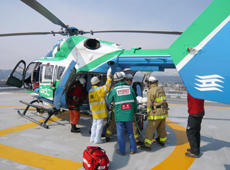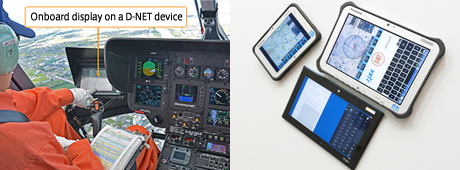
Reduce risks and wasted time in rescue operations
— What exactly is aircraft operation technology for disaster relief?
 Helicopter support during the Great East Japan Earthquake
Helicopter support during the Great East Japan Earthquake
This technology was developed to manage the operation of rescue aircraft, particularly helicopters, more safely and efficiently. The day of the Great East Japan Earthquake in 2011, there were up to 300 helicopters helping rescue victims and collecting information. But information could not easily be shared between all of the different rescue organizations ⋅ the Japan Self Defense Force, the Coast Guard, fire departments, police departments, and emergency helicopters from hospitals.
Imagine that several of these organizations are involved in the same rescue operation, and send too many crews to the same location. Suddenly there are too many aircraft in one place, and for some of them there is nothing to do. Also, there is a limited number of fueling stations, so without proper coordination you can have many aircraft trying to refuel at the same time, creating long wait times. And even more significant, with so many helicopters flying in the same narrow airspace, there is the risk for collisions and other accidents.
To solve these problems, we developed a network that can monitor the location of rescue aircraft and disaster survivors who need aid, so that emergency teams can be dispatched more quickly and efficiently. This system has been named the Disaster Relief Aircraft Information Sharing Network (D-NET).
— How does the D-NET system work?
Previously, communication between disaster-relief helicopters and ground stations was conducted over radio. Each aircraft's location and mission was written on a whiteboard at the emergency response headquarters. D-NET uses satellite communication to exchange information in real time and bi-directionally, and plots the data on computer maps. Depending on their needs, users can select different types of terminals ⋅ for example one that's permanently installed on a helicopter, or a portable one that can be used on any aircraft as needed.
D-NET uses the Iridium satellite to connect ground stations with aircraft in real time, so information from helicopters can be quickly relayed to everyone involved. Any new information ⋅ survivors in need of help, fires, or other problems ⋅ can be disseminated in real time, as of course can directives and detailed mission information from headquarters. Each aircraft's onboard terminal displays positioning information for its destination, mission details, and any other necessary information.
To make sure that access to the system is as wide as possible, we designed standard specifications so that any manufacturer can make terminals. And to make the system easy to use, we increased the size of screen buttons, simplified the procedure to send information, and so on.
Rescuers love D-Net
— How did you test the system?
 Kobe City Firefighting helicopter equipped with a D-NET terminal (courtesy: Kobe City Fire Department)
Kobe City Firefighting helicopter equipped with a D-NET terminal (courtesy: Kobe City Fire Department)
We worked with rescue organizations to test the equipment during actual rescues drills. So far we have participated in wide area medical-transport drills, which are conducted every year by the Cabinet Office; and in aerial firefighting training drills, which present an opportunity to have many helicopters working together.
For example, in October 2012, we ran an experiment comparing a rescue using D-NET and one using the traditional communication method (radio communication and a whiteboard). We used a JAXA research helicopter and a firefighting helicopter from the Kobe City Fire Department equipped with a D-NET terminal.
The result was clear: the use of D-NET reduced communication time by 70%. To the local firefighters, the advantages of D-NET were clear. As a result of this test, the technology has been handed over to private companies for commercialization, and is starting to be used in firefighting helicopters all over the country.
— So this technology is already being put into practical use.
 Fully preinstalled D-NET terminal (left) and fully portable D-NET terminal (right)
Fully preinstalled D-NET terminal (left) and fully portable D-NET terminal (right)
As more helicopters get access to D-NET, rescue efforts will become safer and more efficient. We are working with the private sector to develop new D-Net terminals, and have already started to share our technology with manufacturers. D-NET terminals for aircraft include a display screen and a communication link to the Iridium satellite. With the fully preinstalled terminal, both of these devices are built into the helicopter. This enables a very high level of performance, but requires installation and labor costs in addition to the cost of the terminals themselves. There is also a partially preinstalled terminal, designed to be lighter and less expensive: only the satellite communicator has to be installed in the aircraft, and information can be viewed on a tablet or other portable device. Finally, we have a fully portable model, where both the satellite communicator and the display are portable. This type limits the usage conditions and the information that can be shared, but it is has the lowest implementation cost. Users should choose the type of terminal that best fits their needs.
Saving lives through a coordinated effort in the air and space
— How do you plan to develop the D-NET technology further?
For the next generation of D-NET, we are considering something we're calling the Disaster Relief Aircraft Integrated Management System (D-NET2). This system would incorporate information from satellites and unmanned aerial vehicles (commonly known as UAVs or drones) in addition to aircraft. Satellites are useful for wide-area observations ⋅ getting a broad picture of the entire situation; UAVs can get a close-up look at areas that are too dangerous for helicopters. In most cases, rescue personnel respond to information received from the person needing help, but sometimes this information is not obtainable ⋅ if the disaster has spread over a wide area, or if communication infrastructure on the ground is damaged. D-NET2 will allow rescuers to use satellite images to guide first responders when there is not enough information available through conventional means.
— Tell us about your future plans.

I would like to further develop the collaboration between air and space, and enable faster and more efficient disaster relief. With this is mind, we will continue to work with many different organizations. If everyone involved ⋅ paramedics, firefighters, police officers and medical staff ⋅ shared information using the D-NET system, disaster relief would become even more efficient, and save more lives.
Keiji Kobayashi, Ph.D.

Leader of the Disaster Prevention and Small Aircraft Operation Technology Section
DREAMS Project Team, Aeronautical Technology Directorate, JAXA
Dr. Kobayashi graduated from the Yokohama National University Graduate School of Engineering, Planning and Construction Division, in 1996. Later that year, he joined Kawasaki Heavy Industries, Ltd. to research automated guidance and control of helicopter takeoff and landing. In 2006, he obtained his Ph.D. in Environmental Engineering from the Kyoto University Graduate School of Engineering. He then did post-doctoral research at the Kyoto University Disaster Prevention Research Institute on the use and operational support of helicopters during disasters. He joined JAXA as an Aerospace Project Research Associate in 2006. He has held his current position since 2009.
[ April 1, 2015 ]


